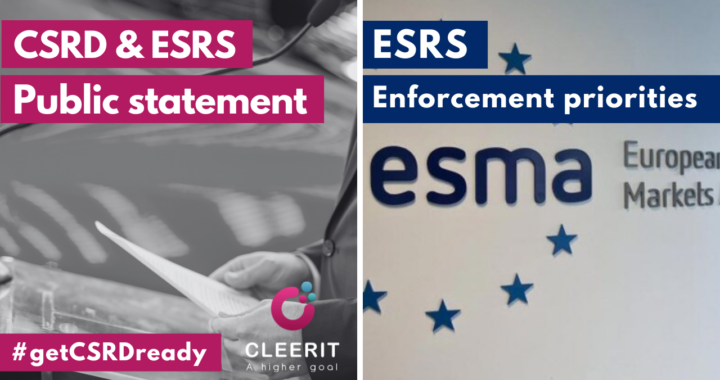On October 24, ESMA (European Securities and Markets Authority) issued its annual Public Statement setting out the European common enforcement priorities (ECEP) for the 2024 corporate reporting of issuers admitted to trading on European Economic Area (EEA) regulated markets.
ESMA, together with national enforcers in the EEA (enforcers), will pay particular attention to these areas when examining the application of the relevant reporting requirements.
Based on the examinations performed, enforcers will take enforcement actions whenever material misstatements are identified and ESMA will subsequently report on their findings.
In addition to these European priorities, enforcers may also set national priorities.
Reduce greenwashing risks and ensure high-quality sustainability reporting
As set out in ESMA’s Final report on greenwashing, with the entry into application of the new CSRD-ESRS regulatory regime, the quality of sustainability reporting is expected to significantly improve thereby helping reduce greenwashing risks.
In July 2024, ESMA issued a Public Statement on the first application of the ESRS by large issuers.
While recognising that this first application is an important milestone in the learning curve of issuers and other stakeholders, the Public Statement highlighted five key areas warranting close attention:
- a) establishing governance arrangements and internal controls that can promote high-quality sustainability reporting;
- b) properly designing and conducting the double materiality assessment and being transparent about it;
- c) being transparent about the use of transitional reliefs;
- d) preparing a clearly structured and digitisation-ready sustainability statement; and
- e) creating connectivity between financial and sustainability information.
Two enforcement priorities
While all these areas remain relevant, two of them have been selected to identify specific enforcement priorities in the present Public Statement.
- Materiality considerations in reporting under ESRS (b)
- Scope and structure of the sustainability statement (d)
Special attention will also be paid to the connectivity between financial and sustainability statements.
Materiality considerations in reporting under ESRS
⭕ Disclosures on the assessment process
Detailed disclosures on the assessment process itself, in accordance with ESRS 2, are key to enable users of the sustainability information to gain a full understanding of the extent of the different steps the issuer has undertaken to reach its materiality conclusions.
This includes providing sufficient information on the activities, business relationships, geographies and stakeholders considered.
ESMA highlights these specific datapoints within the Disclosure Requirement (DR) IRO-1
- 2.53.g – the input parameters it uses (for example, data sources, the scope of operations covered and the detail used in assumptions)
- 2.53.b – the need to disaggregate in the disclosures the processes followed for Impacts
- 2.53.c – the need to disaggregate in the disclosures the processes followed for Risks and Opportunities
⭕ Key affected stakeholders
One crucial aspect of the materiality assessment process relates to the sustainability due diligence process, including the engagement with affected stakeholders.
According to ESRS 1 (section 4), the impact materiality process is informed by the outcome of any sustainability due diligence processes implemented by the issuer.
Disclosures pursuant to DR IRO-1 should clearly reflect this connection.
Regarding the engagement with affected stakeholders, ESMA highlights that several DRs of ESRS 2 relate to whether and how an undertaking engages with its stakeholders, including in relation to its materiality assessment process (DR IRO-1 DP 2.53.b.iii).
In this regard, ESMA notes that FAQ 16 of IG1 clarifies that the objective of such engagement is to obtain the views of the key affected stakeholders.
ESMA expects that issuers provide full transparency in their disclosures in accordance with DR SBM-2 and DR IRO-1 on how they identify and prioritise the stakeholders with which they engage.
ESMA also notes that FAQ 10 of IG1 states that, where possible, the materiality assessment relies on quantitative information as objective evidence of the materiality of an impact, risk or opportunity.
⭕ Datapoints in ESRS 2 are mandatory, including IRO-1 in topical standards
ESMA emphasises the fact that, irrespective of materiality, all DRs and their datapoints in ESRS 2 are mandatory.
This includes all DRs and datapoints related to DR IRO-1 in topical standards, whether or not the related topics are eventually found to be material as a result of the materiality assessment process.
Disclosures pursuant to ESRS 2-related DRs in topical standards, other than DR IRO-1, as listed in Appendix C of ESRS 2, are required if the topic is material.
ESMA stresses the requirement in DR IRO-2 par. 56 and AR 19 of ESRS 2 to list the DRs complied with in the sustainability statement, including page numbers and paragraphs.
Scope and structure of the sustainability statement
⭕ Follow the structure of the ESRS
ESMA encourages issuers to apply the detailed structure provided in Appendix F as an illustration.
ESMA also recommends that issuers which have relied extensively on alternative presentation formats for their sustainability statements carefully consider the compliance of their approaches with the relevant ESRS requirements.
As indicated in the Public Statement ESMA issued in July 2024, on first year application of ESRS:
following the structure of the ESRS in the preparation of the sustainability statements would make digital tagging easier and reduce the burden as the digital taxonomy closely follows the structure of the ESRS disclosures.
ESMA will also consider this common structure of the ESRS disclosures and of the digital taxonomy when consulting and proposing to the European Commission the tagging requirements for sustainability statements.
Connectivity between financial and sustainability statements
ESMA highlights the requirement in ESRS 1 (paragraph 124) regarding the monetary amounts or other quantitative information included in the sustainability statement and that are also presented in the financial statements.
⭕ For such situations of direct connectivity, a reference to the corresponding information in the financial statements is required.
—
Sources (pages 5 and 6 of the statement focus on ESRS) 👇
https://www.esma.europa.eu/sites/default/files/2024-10/ESMA32-193237008-8369_2024_ECEP_Statement.pdf
—
Stay tuned for more CSRD and ESRS insights.
✅ Adopt a streamlined, digital and ESRS taxonomy-centric report preparation with www.cleeritesg.com
